Want to quit fast fashion? Look for low-impact materials
Think hard about what your clothes are made from.
 Credit:
Reviewed / Tara Jacoby
Credit:
Reviewed / Tara Jacoby
Recommendations are independently chosen by Reviewed's editors. Purchases made through the links below may earn us and our publishing partners a commission.
Knowing how to identify a conscious brand can feel nearly impossible, and more often than not, we are told why these fast fashion brands are bad (and shamed for our purchases) with little to no explanation, leaving us alone with the looming question: What does it actually take to be a sustainable brand?
If you’re new to our series on quitting fast fashion, welcome! We’ve already discussed the importance of organizing our wardrobes and diagnosing our social media feeds. Now it’s time to understand what to look for in a conscious brand. This includes learning how a garment is made, what it’s made from, and by whom. To determine whether a brand is genuine towards being more sustainable, we’ll be looking at five aspects: Materials, labor ethics, carbon footprint, the scale of business, and waste/afterlife. In part three of this series, we are focusing on the importance of materials.
We chatted with the team at Good On You, our preferred sustainable fashion directory, as well as Vivek Agarwal, founder of swimwear brand Ookioh, and Gabrielle Gomes, Co-founder at Dinner Service NY, to understand what low-impact materials are and what we should look out for to make informed buying decisions.
What Materials Make Up Your Wardrobe?

The first step to making more informed fashion decisions is learning more about the materials that make up your favorite pieces.
Do you check the care label on a garment before making a purchase? The small tag on the inside of your garment not only indicates how to wash your garment, but also shares essential information—the fiber makeup of your clothing.
Fabrics can be divided into two categories: Synthetic or natural. Synthetic materials (like fluorescent running shorts that make a swishing sound when you run) are man-made using chemicals that are often derived from fossil fuels. Natural materials (think breezy linen summer dresses) are derived from a vegetable, animal, or mineral source. Upon knowing this division, we need to be aware of what fabric options have the lowest impact.
Fast fashion giants like H&M, Shein, Zara, Forever21, Pretty Little Thing, and Boohoo mostly rely on fabrics that will ensure the lowest cost possible but usually have the highest environmental impact. The fabrics chosen by these brands are most commonly synthetic due to low-cost production and use of versatility. You’ll continually see a rotation of polyester, nylon, and acrylic in their collections. If natural fabrics appear in their collections, for example, cotton, it is usually produced using conventional manufacturing processes that are chemical and water-intensive.
If we can choose to buy a garment based on what fabric it is made of, this can be a huge win for the environment. What fabrics make up the majority of your wardrobe? Audit the top 10 pieces you wear weekly and check the care labels. If they are mostly synthetic, keep reading to learn more about low-impact materials.
Identifying Low-Impact Materials

Now that you know about the materials you already have, learn more about sustainable fibers that could be a smarter choice.
“All materials will have some impact on the environment,” says the Good On You team. “However, there are those that have inherently lower impacts across areas such as chemicals, water use, soil, and emissions. But switching out more harmful materials for lower-impact alternatives is a key strategy to reducing environmental impact.”
Participating in more sustainable fashion choices may feel overwhelming. However, understanding the importance of low-impact materials is an easy first step in rethinking your relationship with your clothes. Good On You continues “Lower impact materials include recycled, organic, and regenerative cotton in preference to regular cotton, hemp (preferably organic), and organic linen. Instead of rayon and viscose look for Tencel.”
Each brand sources different fabrics based on garment aesthetic and function, however sticking to naturally derived fibers (regardless of the brand) is a great rule of thumb. By sticking to a rotation of naturally derived materials, brands like Dinner Service NY are able to (somewhat) control the after-life of the garment. “Our core fabrics include recycled cotton, GOTS-certified organic cotton, hemp, and OEKO-TEX-certified lyocell,” says Gomes.
Fast fashion brands don’t consider the impact their products have on the environment or on people when choosing what to produce. However, for Ookioh this consideration guides their assortment. “There are so many products we want to make, but unless we can offer them in an eco-friendly material, we don't work on those categories,” says Agarwal. “Even when making products from (more) sustainable materials, we are constantly looking for greener options.”
The Power of Recycled Materials

Opting for recycled materials is an easy way to dip your toes into sustainable materials.
Beyond producing new naturally derived fabrics that have low impact, one of the best choices is to purchase garments made from recycled materials. We already produce so much, so why not divert fashion from landfills and keep reusing it?
“Recycled cotton is a staple in our assortment, which is made from upcycling cutting room scraps, and requires no additional natural resource input to create,” explains Gomes. “There are some limitations to this, such as color, but rather than milling and dyeing new fabric we are able to save fabric that might go to waste otherwise.”
Ookioh takes the same approach to their fabric scraps. “We use leftover fabrics from our swimwear to make the cases for our sunglasses, and the scraps from our towel manufacturing process are sent back to the mill that produces the yarns from recycled cotton,” explains Agarwal.
Many brands also boast the use of recycled polyester. “Recycled polyester is a better choice than polyester.” states Good On You. “However almost all recycled polyester currently on the market comes from plastic bottles; we don’t want to incentivize the creation of more plastic bottles, and they are probably better off being recycled back into bottles rather than into fabric that is hard to then recycle again.”
So, What Next?

Every purchase you makes says something about who you are and what you're willing to support. Stay informed and make the environmentally-friendly choice!
It’s a privilege to be able to pay such close attention to the materials and brands that make up sustainable styles. However, investing in low-impact materials is one of the most impactful actions you can take for both people and the planet. Rather than purchasing five one-piece swimsuits that cost $35 each (and may not last a single season), it can be the more economical choice to buy one better-made swimsuit from Ookioh that will last for years.
When investing in well-constructed clothing made of conscious materials, you can also guarantee a longer lifespan for your clothing. However, that begins with the proper care of your garments. Handwash your swimwear and knitwear, use natural detergents that are free from harsh chemicals, and opt for washing your garments with cold water. These practices not only preserve the integrity of the fabric but also minimize environmental impact by reducing the need to replace garments frequently.
Finally, research will always be your best friend, and Good On You’s Directory is here to assist. Utilize their website and app to learn more about your favorite brands and find more conscious alternatives to the fast fashion giants.
Our Favorite Pieces from Ookioh

Reach for these high-quality pieces from Ookioh when you’re focusing on better materials.
Galle Towel
Beach towels are often an afterthought for many, especially if you’re not living in a coastal town. The Galle towel should not be an afterthought. Ookioh uses Italian yarn, made from 60% recycled cotton and 40% organic cotton, and they apply a skin-friendly Silver Salt on the towel to kill bacteria and reduce the need to wash it often: Beautiful, sustainable, and strategic.
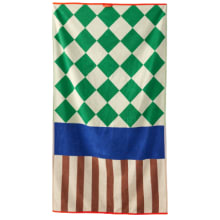
Whether it’s the carefully considered materials or the skin-friendly salt wash that keeps it cleaner longer, we love this beach towel.
Madeira Sunglasses
I wear the Amber colorway of the Madeira Sunglasses every day, and to date, they’re the best sunglasses I’ve ever owned. Ookioh is one of the few brands in the world offering bio-based lenses and bio-based acetate frames in their sunglasses.
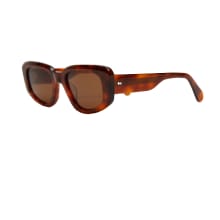
You’re doing the planet a favor by making these glasses your next sunsafe accessory.
Agadir One Piece
A classic black one-piece is a swimwear staple that will carry you through many summers. This particular suit was released in 2020 and made entirely in Los Angeles. The fabric manufacturing, to the construction of the suits, was done within a 25-mile radius of Ookioh’s warehouse.
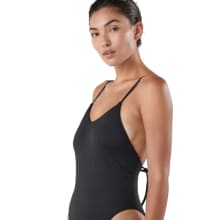
Before your next trip, consider shopping a swimsuit that’ll last for your next ten trips.
Our Favorite Pieces from Dinner Service NY

Want to start making more informed fashion choices? Begin with a brand like Dinner Service NY.
Kota The Friend x DSNY Protea Bowling Top
“Our capsule drop model enables us to never produce more garments than we can sell within a 2-3 month time frame,” says Gomes. We love this as the brand can continue offering unique styles like this printed Bowling Top, that allows for no product to go to waste.
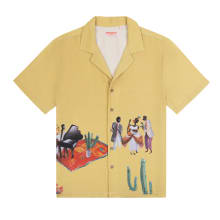
Snag this vibrant printed shirt to add some personality (and thoughtful consideration) into your wardrobe.
Kota The Friend x DSNY Socks
These socks are a blend of organic cotton and a new fiber derived from the waste of banana farming. It's a reminder that we can make sustainable (and stylish) choices right down to the socks we choose to wear.
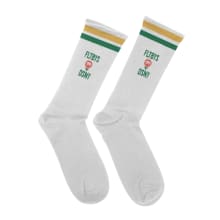
We highly suggest making smarter material choices, even with your most basic wardrobe staples.
Kota The Friend x DSNY Protea Cardigan
A fusion of beauty and conscious design, this cardigan is so visually appealing that Dinner Service NY’s sustainability efforts are just an added bonus to the fun and colorful style.
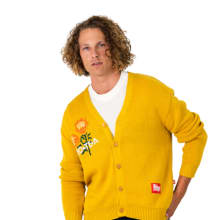
This colorful sweater isn’t just cute, it’s a smart choice thanks to Dinner Service NY’s commitment to sustainability.


